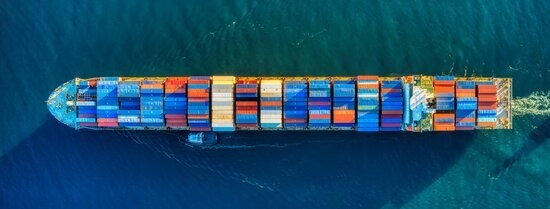Container ships are becoming increasingly colossal in size. This contributes to congestion, with ships sometimes facing difficulty disposing their containers at the port. The container market is also very sensitive to shocks, as was evident during the corona pandemic. How does this market function and what processes play a role? A study facilitated by the Convergence collaboration between Erasmus University and TU Delft provides interesting insights.
The largest container ships are now over 400 meters long and carry more than 24,000 TUE containers (of twenty feet). With larger ships, shipping companies hope to earn more. Still, profit margins are small. Before the corona pandemic it was sometimes even free to transport a container from Asia to Europe. On the contrary, during the lockdowns prices shot through the roof. "The container market derailed," says Professor of Transport and Logistics Albert Veenstra of Rotterdam School of Management. "The problems piled up: because of Covid, Chinese ports and factories closed, and on top of that came the blockade of the Suez Canal by the jammed Ever Given. Later, strikes in the port of Hamburg also followed."

"The large ships reinforce that vulnerability because the ports and the hinterland have not grown sufficiently with it"
Albert Veenstra
'Perfect storm'
Shipping companies foresaw an economic crisis due to the pandemic and shot into their usual reflex: sail less fast. Consumers, in part because of all the government support, actually spent more, which meant that more transport was also needed. Veenstra speaks of a "perfect storm" that exposes how vulnerable the container market and thus our transport system is. The large ships reinforce that vulnerability because the ports and the hinterland have not grown sufficiently with it. "In extreme situations, it happened that a ship lay endlessly at the quay. Only when a truck came could a container be taken off the ship again."
The Top Sector Logistics also saw that ports were getting stuck and wanted to gain more insight into the causes. The research component from the Center for Urban, Port and Transport Economics (UPT) consists of an economic analysis of shipping companies and maps their trade-offs. Together with research firm PortWise and Alexander Verbraeck of TU Delft, a simulation study was also conducted. With this model, 'container peaks' can be simulated to provide insight into where the bottlenecks are in the transport chain. According to Veenstra, the combination with the Delft expertise is very valuable: "We would never have been able to build a model so quickly. And at UPT we have an understanding of the economic factors that are decisive. That's why this is such a great combination."

Port hopping
According to Veenstra, the Port of Rotterdam is still the only port in Europe that can handle the largest container ships. That seems like a luxury position, but in practice it often works out unfavorably. "These ships first come to Rotterdam, then make a tour of other ports and then make another stop here before sailing back to Asia," he says. The bottom line is that the Rotterdam port accommodates the very largest ships for the benefit of other ports in the region. "Ports prefer to fully handle large ships. The study shows that you lose the economy of scale if you split the handling between different ports."
The increasingly larger ships are partly due to the exemption position shipping companies have in Europe. Whereas competition rules in the EU are very strict for many sectors, shipping companies are allowed to cooperate and share capacities among themselves. "Our contention is that shipping companies afford themselves a lot by introducing bigger and bigger ships. It also contributes to the jamming of logistics in ports," says Veenstra.
Exception position under discussion
The exception is therefore under discussion, with the EU having previously postponed the verdict on the competition law a decision should be made this spring. According to the professor, it is not clear whether it is wise to abolish it. No one can oversee the consequences and there is no time to study it further. "Transport costs are very low again at the moment and there is a risk that the container market will collapse. We may desperately need this exemption for shipping companies to keep world trade afloat. If there are bankruptcies, the world is going to suffer a lot."
For the study, many interviews were conducted with all parties in the transport chain. Those interviews revealed that there is no single party to blame for the congestion. "That was a big eye opener for us. Everyone in the transport chain is stuck in the same system and nobody has an interest in congestion," says Veenstra. What also emerged from the conversations is that parties from the port, and the onward transport, do not enter discussions with shipping companies at all.

"The container market is expected to grow about 40 percent over the next four years. We need to start thinking now about where new bottlenecks may arise"
Albert Veenstra
Anticipating the future together
The most important recommendation is that all parties, including shipping companies, should talk to each other. For example, every shipping company has different plans for the future, such as one that wants to focus entirely on refrigerated transport. Large companies, such as supermarket chain Lidl, are also increasingly shipping small container ships themselves. Something that ports must then be able to facilitate. Conversely, it is just as important for carriers to know what ports are planning. Subsequent transport via road, rail and inland waterways must also grow sufficiently with it, Veenstra emphasizes. "The container market is expected to grow about 40 percent over the next four years. We need to start thinking now about where new bottlenecks may arise."
- Related content

